|
Of all the creatures that call the Sonoran Desert home, none are more unexpected than amphibians. They have several adaptations that would seem to make desert life impossible – they lay their eggs in water, the young must live in water, and their skin is especially susceptible to drying out in an arid environment. Because of this, amphibians spend most of the year underground in burrows that they or other animals have dug. They are more likely to be seen after summer rains near temporary or permanent water sources as they race to feed and reproduce. 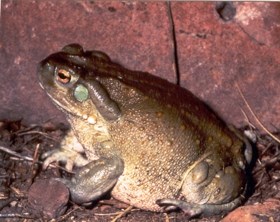
NPS Photo Colorado River ToadIncilius alvarius Body Length: 4 - 7 1/2"

NPS Photo Great Plains ToadAnaxyrus cognatus Body Length: 1 3/4 - 4 1/2" Great Plains Toads are a species rarely seen but likely common. Found only in the desert areas of Tonto National Monument, north of Route 188, Great Plains Toads were not detected here for many years. Like many desert toads, they emerge from underground almost exclusively during summer rains. Like some other amphibians, males Great Plains Toads can exhibit an unusual breeding behavior. They give loud advertisement calls to attract females to their a pond or stream. Meanwhile, a smaller number of "satellite males" or "cheaters", wait silently nearby. As females approach, the satellite males attempt to intercept and breed with them, effectively stealing them from their more vocal rivals. Research indicates that more than half of all males try this tactic at some point. Evidently, cheaters sometimes win! 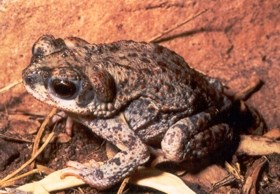
NPS Photo Red-spotted ToadAnaxyrus punctatus Body length: 1 1/2 - 2 1/2" Red-spotted toads are named for the small red spots which cover the back of adult toads. This small species of toad is mainly nocturnal; often seen hopping on roads during spring and summer nights. The call of the Red-spotted toad is a high-pitched, prolonged musical trill, given by males to attract females to temporary ponds and stream pools where they breed. What follows is the typical frog and toad life cycle: Amplexus occurs when the male grasps the female at mid-body and externally fertilizes the egg as she deposits them one-by-one onto the bottom of the pool. Tadpoles soon hatch from the eggs and, within a few weeks, metamorphose into tiny toads. After the toads leave the pool, they live the rest of their lives on land, returning to water only to breed. 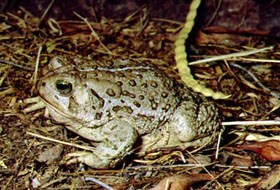
NPS Photo Woodhouse's ToadAnaxyrus woodhousii Body Length: 1 3/4 - 5" Diet: Insects. This large toad is found near permanent water, floodplains, or feeding in gardens after dark. It is named in honor of SW Woodhouse, who served as a surgeon-naturalist on a boundary survey prior to the Civil War. Reportedly pierced by an arrow and bitten by a rattlesnake in the field, Woodhouse survived to collect the type specimen, or the first of this species known to science. Woodhouse's Toad is a widespread species found from Washington state to New Hampshire. Its call is a wheezy sound that has been compared to a snore or bawling calf. 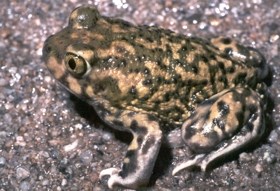
NPS Photo Couch's SpadefootScaphiopus couchii Body Length: 1 1/4 - 3 1/2" Couch's Spadefoots are the original couch potatoes. For most of the year they sit in holes deep underground. Stimulated by the sound of the first summer rains, Spadefoots burrow upward and emerge into the wet desert. Hopping to temporary pools created by the rain, the males call loudly to attract females. Over 90% of breeding occurs on the first rainy night. Following breeding, the eggs and larvae develop faster than any other American frog or toad. In warm water, eggs hatch within 15 hours. While some frog tadpoles take over a year to develop, spadefoot tadpoles metamorphose into toads in 11 - 12 days. Scientist have determined that this remarkable toad is capable of eating enough food in one evening (up to 55% of its body weight) to survive an entire year! The "spade" located on each rear foot is a small knob which helps this species dig more efficiently. 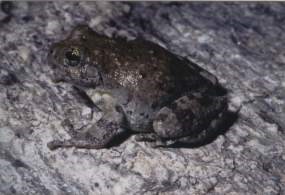
NPS Photo Canyon TreefrogHyla arenicolor Body length: 1 1/4 - 2 1/4" Frogs are usually associated with cool, wet places, but this frog can be found out in the sun on some of summer's hottest days - though spotting them can be a challenge. Canyon Treefrogs are masters of camouflage, with an uncanny ability to quickly match their skin color to the patterns of rock. If you look closely in rocky pools, you might find one overlooking the water, using its adhesive footpads to cling to the surface. In spite of its name, this species is rarely found in trees. At Tonto National Monument, Canyon Treefrogs occur in the creek near the Visitor Center. Starting in March, they can be heard calling at sunset, and sometimes during the day. The call is a strange bleating sound. Only males call, hoping to convince females that the pools below are ideal for the survival of eggs and tadpoles. |
Last updated: December 26, 2020
